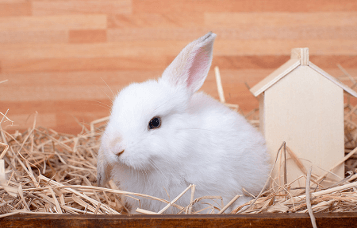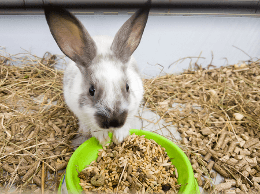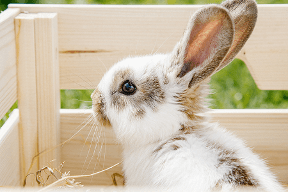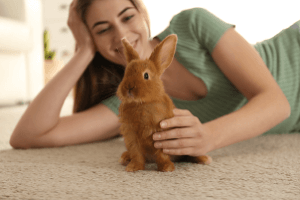How to Choose and Look After a Rabbit

Before arrival day, you’ll need to get your home ready for your new rabbit so that it’ll be able to adapt to its new home more easily, helping you to attend to it properly from the word go.
If you’ve never had a pet rabbit before, you’ll probably be very excited as its arrival day approaches. However, you may also be a little nervous with lots of questions about what to do and what not to do.
Don’t worry, we’re here to help! We’re going to be sharing some tips so that you can get your home ready for your new rabbit, ensuring that it’ll have everything it needs. Are you ready? These important tips will help you look after your rabbit in the best possible way!
5 tips to get your home ready for a new rabbit
The main thing you need to keep in mind is that a rabbit requires a lot of attention and care in order to keep it healthy and happy. So, if you’re thinking of getting one, you should accept your responsibility to look after all its daily needs.
Learn all about the general care rabbits need, and any additional needs they may have according to their breed and character – just so that you’ll know what to expect. Then, once you’re clear about everything, you can start to get things ready.
1. Get a suitable cage
Getting your home ready for your new rabbit means you should have a cage (or hutch) properly installed beforehand. This should be at least two or three times bigger than the size of the rabbit when it’s fully grown. Bear in mind that it will sleep, eat, and go to the toilet there, so it isn’t advisable to skimp on space.
You should place the cage in a quiet place where there isn’t too much movement or noise, and, preferably, where the light is dim. Of course, you’ll need to clean and prepare the cage well.
To do this, you should place a layer of newspaper substrate on the floor of the cage and plenty of hay, which will make them feel at home, as well as providing something for them to gnaw on to keep their teeth in good shape and to help their digestion.
Another factor you must take into account regarding the cage is that it must be easily accessible to the rabbit. When you let it run around the house to give it some exercise then you’ll need to ensure that it can easily find and access its cage again when it needs to.
2. Provide a place to shelter inside the cage
Some people recommend filling half of the cage with hay so that the rabbit can use it as a type of refuge, shelter, nest, or den, to comfort itself when it wants to.
In the rest of the cage where there isn’t any hay, you should place a drinking bowl with clean, fresh water and its feeding bowl. Don’t fill the feeding bowl right to the top – just give it what it really needs so that it can eat whenever it needs to. Both containers must be accessible so that the animal doesn’t have any problems getting to them.
We also recommend that you provide it with the same brand of food that it used to eat at the pet shop or shelter where it used to live before coming to you. In this way you’ll avoid potential health problems.

You should choose small drinking and feeding bowls for the first few days, and they shouldn’t be too deep. If you put in a traditional water bottle then, at first, the rabbit may not know that it has to suck on it to drink.
The drinking bowl should always be located near its shelter area – which could be a type of small house or simply where the hay ball is. In that way, your rabbit will be able to identify and access it easily. Then, in time, you’ll be able to install a drinking bottle in the same place as the water bowl, and, in that way, your rabbit will realize what it is more easily.
3. Look for a suitable pet carrier
In order for your rabbit to arrive at your house comfortably, you’ll need to look for a suitable pet carrier. You should place some hay inside the carrier to ensure that the animal feels at home and is as calm as possible throughout the journey.

4. Give your rabbit time to get used to its new surroundings
Even though it’s important for your rabbit to get used to you, you should carry out this process little by little so that it doesn’t get stressed. Keep in mind that it’s a big change for the rabbit, and, for the first two or three days or so, it’ll need a lot of peace and quiet to get used to things.
You should let it spend time in its cage, only picking it up for short periods of time – and always very gently. In this way it will have plenty of time to explore and get used to its new home.
As time goes on, you can let your rabbit have more and more contact with you, and for longer periods of time. You can even start interacting with it and training it in phases.
While your pet is getting used to you, you can check out some ways to train a rabbit well so that you can get an idea of how to train it, and what sort of goals you’d like to achieve in order to help you bond in the best way possible.

5. It’s always a good idea to find out how to train your rabbit
As well as getting your house ready for your new rabbit, it’s important for you to learn how to train your rabbit well right from the start. In this way, your pet will get used to a series of fixed guidelines and you’ll be able to interact with them more easily, without it affecting their well-being. If you train your rabbit well right from the start, the bond between you will be much better and it’ll be a positive experience for both of you.
The training will need to be useful, so that the rabbit learns where it needs to go to the toilet, and not just how to do different tricks. This will also have benefits for the rabbit’s well-being, and they’ll learn to act and interact with you in a healthy way.
You may be interested in: Tips About Having a Rabbit at Home
Get an appointment with your vet
Some experts recommend taking the rabbit for its first check-up with the vet in its first week in your home. In this way, you’ll be able to check up on their health and attend to any problems with the necessary treatment, avoiding complications that could affect their well-being.
It’s worth mentioning that even when your animal is healthy, you still need to have regular check-ups. These will help you get to know your pet a little better so that you can provide them with the best daily care. So, make sure you take advantage of your local vet and all their knowledge!